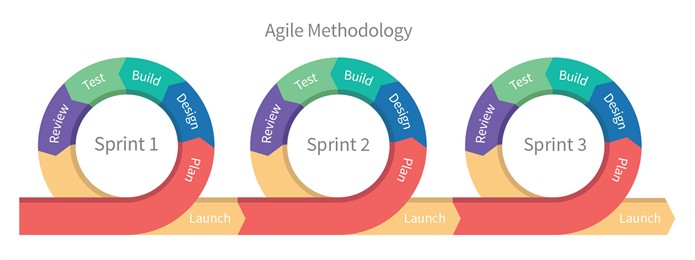Today, the principles and practices of the agile method have been widely adopted all over the world. Nonetheless, testing within agile projects can be quite challenging. Discover the ins and outs of the agile methodology as well as advice how to enhance your agile testing practices.
What is the Agile Method?
The Agile Method is an approach to software development where a team made up of developers, testers, a project manager, and product owner work together to build a product, chunk by chunk.
With quality assurance (QA) testing incorporated in each iteration, a maximum number of bugs can be found allowing developers to alleviate problems and add new functions to the product simultaneously.
It’s like building a house. You start with the foundation to provide stability. Next, you build upon the foundation adding the first floor. After passing a thorough inspection, you’re ready to add an second floor which is made possible by the previous work, but will nonetheless enhance the entire house.
Overview of the Agile Method
The Agile Method is composed one or more sprints or iterations. Each sprint is made up of several phases including the Plan, Design, Build, Test and Review phases.

Tasks are carried out by a scrum team consisting of
- Product Owner: The creator or owner of the product
- Scrum Master: Project manager who leads and oversees the entire scrum team.
- Developers: Coders who build the product.
- Testers: Quality assurance testers who assess the product for bugs or defects.
How Does The Agile Method Work?
Each sprint begins in the Plan Phase where the scrum team meets to decide which functions should first be built, leaving the remaining ones to be built in the later sprints. To do this, the product owner creates “User Stories,” which define each function the final product will have from the perspective of the customer and their needs.
After picking the function(s) to build, it is the job of the scrum master to establish a timeframe for the sprint, usually lasting between 1 and 4 weeks. Nonetheless, the later sprints are allocated the same amount of time as the first sprint.

User Stories: As a first-time user, I want to be able to create an account using my Google or Facebook account, so that registering is easier and quicker.
Knowing the features and timeline, the scrum team shifts into the Design Phase where the developers design a plan to build the functions chosen for the sprint.
With a plan in hand, the developers move to the Build Phase constructing the product according.
Once the functions have been completed, the baton is passed to the testers in the Test Phase who, using a testing plan, asses the developer’s work for any bugs that are logged in a report.
At the end of the testing period, the scrum team comes together in the Review Phase to review the test report to decide which bugs need to be fixed immediately or addressed in the next sprint. The team also decides which tests will be automated and repeated for the remaining sprints.
Automated testing is key to agile method since it allows the team to continually and easily test both the original and new functions as the product is updated in each sprint.
The end of the review phase concludes the entire sprint allowing the team to transition to the next one until the final product is complete and ready to be launched.
- Sprint 1: Choose User Stories - Build - Test - Update
- Sprint 2: Review Sprint 1 (Automated Testing) - Choose New User Stories - Build - Test - Update (Sprint 1-2)
- Sprint 3: Review Sprint 1 & 2 (Automated Testing) - Choose New User Stories - Build - Test - Update (Sprint 1-3)
- Sprint 4....
Benefits of the Agile Method
- Shared Responsibility: Planning, designing, and reviewing the product as a team ensures that the whole team is responsible for its success as opposed to just one specific aspect of it.
- Active Collaboration: The team nature of the Agile Model enables members to actively collaborate with each other throughout the entire process allowing them to share ideas, concerns, and problem solve as a collective group in daily meetings.
- Clear Communication: The “User Stories” define exactly how each feature will function reducing the likelihood of miscommunication or the need to interpret vague instructions that can lead to misunderstandings between team members.
- Established Criteria: The Agile Model is built upon having clearly established criteria for success for every aspect of the product that can be easily measured by the testers to ensure that the quality is satisfactory.
- Assured Quality: Testing is implemented throughout the entire production process to ensure that the product is functioning as intended.
While products developed using the Agile Method may be completed faster than using other methods, the most important aspect is the fact the product will match expectations of the product owner and the needs of the users.
Best Practices
To get the most out of the Agile Method, there are some practices to keep in mind when it comes to testing. At StarDust, experienced testers and project managers offered advice on the best practices.
Use appropriately designed tests to best assess the functions according to the needs of the developers. Creating a test that does more than what is necessary can be a waste of time.
- Automated regression testing is important throughout each sprint. Additions made to the digital product can produce bugs that affect the other functions have been previously developed and tested.
- Determine all the functions that need to built at the start of each sprint so all members are on the same page. Confusion will only hamper the project.
- To respect tight schedules, testers and the developers should avoid going back and forth in trying to retest every bug correction individually. This ends in a lot of lost time.
- Create a detailed bug report to help the developers fix them more efficiently. Testers must provide precise details including where the bug was found, how to reproduce them, screenshots, etc. If not, it will be much more difficult for the developers to fix bugs they cannot find or reproduce.
To know more about testing in an agile environment, feel free to download our white paper that specifically focuses on the role of testing within the agile method.









